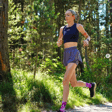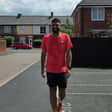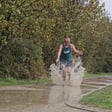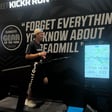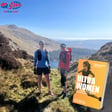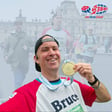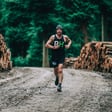Become a Creator today!Start creating today - Share your story with the world!
Start for free
00:00:00
00:00:01

Craig Downs
Craig is a runner and founder of mymo, a product he designed and brought to market which measures your gait and helps you to find your next pair of running shoes.
Craig talks about why he started this and describes the journey over the last 4 years to bring the finished Mymo product to runners.
You can follow Mymo on:
Transcript
Introduction and Guest
00:00:01
Speaker
Welcome to this week's podcast episode. Joining me today is Craig Downs.
What is MIMO?
00:00:06
Speaker
Craig is a runner and founder of MIMO product. He designed and bought a market which measures your gait and helps you to find your next pair of running shoes.
Community Engagement
00:00:17
Speaker
He also joined in on the UK Run Chat Hour on Sunday and really interested to get your feedback on this one. So do drop us your comments and questions on our social channels and enjoy hearing all about MIMO and Craig. Thank you.
Running and Weather
00:00:36
Speaker
Welcome Craig. Thank you very much. How are you doing?
00:00:39
Speaker
Yeah, I'm very well. Thank you. How are you? Yeah, good. Thanks. I'm good. It's, I'm just looking out the window there and it's raining and I'm sort of contemplating I need to go out for a run this afternoon. And so I'm hoping it's going to ease off a little bit.
Craig's Running Journey
00:00:50
Speaker
Yeah, we're a bit cloudy here today in Shopshire, but it's dry at least. We've had all the floods and I took the dog out last night and they've actually receded back off our usual route now. The river's back in its banks, thankfully, so I'm going to head out later around the mucky river route from where it's flooded. If it's not flooding, it's been snow, hasn't it? Because there's been quite a lot of snow. There's a few days as well.
00:01:18
Speaker
all interrupting the training, but it's still got to be done and it makes us stronger. That's what they say, isn't it? If you go out in these conditions, it makes you stronger when it's in the summer. That's it. That's it. Thanks for coming on. Thanks for having us. Thanks for being involved in UK Run Chat. Tell us a bit about yourself and you and your running before we head into what bimo is.
Marathon Experiences and Club Involvement
00:01:44
Speaker
Yeah, I started running probably 10 plus years ago. I really started just to kind of get fit and I really enjoyed the exercise and the sort of adrenaline that you got from going out from a run, the satisfaction I think as well as
00:02:04
Speaker
getting the exercise and getting the fresh air, I think for me it was also about sort of giving myself some time to myself, just sort of giving yourself time to go out and just think about things and you know, in terms of my job, I've got a PR agency that I run and it came to be quite stressful, so it was just a good opportunity just to get out really and clear your head.
00:02:27
Speaker
That's how it all started and then I started doing park runs and then got the bug and started to enter a few races as you do, did the Great North Run, I'm from Durham, so the Great North Run's on our doorstep, so did the Great North Run and that's how it started and then I decided to join a club just to compete and try and progress and improve.
00:02:57
Speaker
And, you know, I'm not, I'm not at that high level, but, you know, I enjoy competing and I enjoy, uh, sticking the vest on and having a good blast out now and again. So, yeah. So that's me. Yeah. Yeah. That's what it's all about. No, I couldn't agree more than all the benefits that go along with running, you know, keeping me in me.
00:03:17
Speaker
in my jeans and allowing me to have a beer at the weekend if I want one. The biggest thing for me is headspace. Definitely. Which club do you run for?
00:03:31
Speaker
I've actually just changed clubs. I actually now run for Berkeley So in the Northeast Northeast Club, I haven't been able to train with them yet though because of lockdown so So but I'm obviously training individually and then hopefully we'll be able to once this lockdown restrictions are eased we'll be able to to be able to to get out and Meet my new club members and compete which will be good
00:03:58
Speaker
Yeah, but what events have you took part in and have you got a favourite? It's more road running. I do a lot of road running, everything from 5k all the way up to marathon distance. I've done five marathons now. I haven't done one for a couple of years. The last one I did was London in 2018 when it was red hot. No, boiling.
00:04:24
Speaker
Yeah that was the last marathon I did but my quickest marathon time is three hours and three minutes and that was that I did in Amsterdam so I was obviously targeting sub three hours but didn't quite get there but still pleased with the time but I don't
00:04:46
Speaker
I think it's the training that goes into a marathon it's the commitment and when I've got a family and you know I've got work and it's just having that time so I regularly participate in 5k and 10k's and I'll do the odd half marathon.
00:05:03
Speaker
I do the cross-country as well with competing with the club and I've done quite a few cross-countries. I've done the Nationals in London and some of the northern cross-country races.
00:05:19
Speaker
I don't love getting, I don't really love the sort of cross-country, but I'll do it, you know, and I'll do it because I do it to try, because I'm competitive, so I do it to try and score for the team. Yeah. Yeah. Nice.
Why Develop MIMO?
00:05:36
Speaker
Cool. So tell us about Mima then, what is it and why did you come up with this product?
00:05:43
Speaker
Um, well, like I've said, I'm, I'm just a normal runner. And, um, I few years ago, um, that was actually training for one of the marathons and I, I decided to go and buy a pair of running shoes for to do tempo sessions in lightweight, sort of a lightweight shoe that would allow us to do sort of tempo sessions.
MIMO Development
00:06:05
Speaker
Um, and I went into a store and I, uh,
00:06:08
Speaker
bought a pair of shoes that was advised, recommended, and over time I've developed an injury, which I sort of point back to the shoes that were actually the incorrect shoes. And while I was out injured, it's like what I've seen before when I go out running, I do a lot of thinking. So when I wasn't running,
00:06:29
Speaker
I was still doing a lot of thinking and I was thinking you know there must be something out there in the marketplace that you can buy as a personal product that you can buy that you can just you know wear it and it'll measure your gait and it'll actually guide you to buying the right type of shoes you know to avoid getting injured
00:06:53
Speaker
So I started doing some research and I found that there wasn't anything in the marketplace. So that's how the idea came about. So this was probably four, maybe five years ago when I first came up with the idea. And it's taken this amount of time to actually bring this product to market because there's a lot of
00:07:19
Speaker
I keep saying to friends, it's not like if you're just making a beer mat, for example, it's quite easy. You just get a big sheet and you just die cut them and print them and there you go. With what we've done is we've sort of brought a lot of technology together. So it uses sensors obviously that you wear on your foot to measure your gait. We've got software and we've built a mobile app. We've got a database in the cloud, which
00:07:45
Speaker
holds all the data of all the shoes. We've got an algorithm which processes all the data and matches your running style of
Gait Analysis Consistency
00:07:54
Speaker
all the shoes. So there's a lot to it and that's why it's taking so long to actually get to market. So that's how the idea came about and that's how long it's taken. So we launched just at the end of October, 30th of October, just before Christmas really. So still early stages.
00:08:13
Speaker
Yeah so you've you've turned what typically is a service in a retail store for example so you can go into lots of them can't you and and somebody who is trained will watch will will record you run on a treadmill and then really with the naked eye they'll they'll look at they'll look at your gate and um you've you've turned it into a product um yeah just can we just strip it back because there's so many new runners
00:08:42
Speaker
over the last 12 months just explain what running gait is just for just for those new runners who are listening so there's different types of shoes that you can buy there's a like neutral shoes or support shoes and in order to understand what type of shoe would be right for you
00:09:01
Speaker
you need to get what you call a gate analysis and like you say go into a store and you can do this or you could buy a MIMO and what it does is it looks at how you run, it looks at how and where your foot lands on the ground so it looks at
00:09:18
Speaker
impact the foot has when it touches the ground, whether you heel strike, whether you're midfoot or whether you're on your toes and it looks at any areas of pronation which looks at how the ankle, if the ankle collapses inwards or rolls outwards and that's what
00:09:37
Speaker
basically looks at your gate. There are other elements to it as well. So what a gate analysis can also do is look at other weaknesses within your biomechanics. So if you've got a weakness in your knee or your ankle joint, it can pick that up as well. So it's looking at your running cycle pattern and then slowing that down and really sort of analyzing it to, to then determine what is the right shoe for you. Like I say, you can get different types of shoes. So it's, and it's important.
00:10:07
Speaker
you
00:10:08
Speaker
So like in my experience where, unfortunately, I bought the wrong pair of running shoes. So I needed a support shoe. So my foot actually collapsed. It pronated. And what I ended up doing was buying a neutral shoe. And because I was doing the mileage, because I was doing the marathon training, over time, every time my foot hit the ground, it kept collapsing. There was no support.
00:10:37
Speaker
And eventually the Achilles started to flare up and that's what happened. So it is important. I know you go into these running stores and there's so many different shoes on the racks.
00:10:55
Speaker
Different brands, different technologies, different styles, different technologies. How do you know which is the right shoe for you? So the first part of the process is to do the gait analysis to sort of narrow that down. And you write what you say that you can go into a stone and you can do it on a treadmill. Sometimes they'll ask you to
00:11:14
Speaker
So this is the other thing, and this is the reason why I decided to develop MIMO is because there isn't any consistency in how a gate analysis is undertaken. And what I mean by that is that, first of all, sales assistance
00:11:30
Speaker
You know, they're not necessarily qualified to do a gate analysis. It's done by experience. And like you say, it's done from just them watching you and it's their experience of what they've seen. And some shops have, you know, very experienced, knowledgeable staff and some don't. So, you know,
00:11:53
Speaker
Where's the consistency? And it's how it's delivered. So, for example, in the Northeast, there are shops where you can go in and they'll just ask you to take your socks and shoes off and watch you walk. And that's it. That's how they measure your gate. If you go to another store, they'll ask you, like you said, they'll ask you to run on a treadmill. Now, sometimes they'll ask you to run barefoot on a treadmill.
00:12:15
Speaker
sometimes they'll ask you to wear a neutral shoe. Now our argument is that even if you're wearing a neutral shoe it's not a natural measurement of your gait because even wearing a neutral shoe is giving your foot an element of support.
00:12:29
Speaker
So it's not really a true reflection of your gate. So there isn't really any consistency in how the, you know, how a gate analysis is undertaken, whereas what we've developed is it's digital, so it's consistent. And it's, you know, and it also gives you that data as well, because I think sometimes you go into these shops and they'll say, oh, you're this.
00:12:55
Speaker
And then what happens is you take their advice, you buy your shoe. Six months down the line, you decide you need to buy another pair of shoes because the credit ran out. And then you think, oh, I can't remember what I was. I can't remember what my gate was. Whereas with MIMO, you've got a record of all your tests that you've done, which you can do as many times as you want. And you can look back over how your gates changed and your gates can and does change. So I said, when I got injured, I needed to support you.
00:13:21
Speaker
And because I had the problems with the Achilles, I had physio. So what I did was I did a lot of ankle exercise, strengthening exercises around the ankle joint. And what's happened is I've now actually sort of progressed and I've transitioned and now I need a neutral shoe. So my foot doesn't collapse anymore. So I've gone from wearing a support shoe to a neutral shoe.
00:13:44
Speaker
and that's because I was injured, I was doing all the exercises I was told to do and that's the sort of issue that I need now. So a gate can and does change but how a gate analysis is delivered across all the stalls, I'm not saying this, I'm not single out any individual stalls here, I'm just saying
00:14:07
Speaker
You can go into different stores and you can be told different things.
How to Use MIMO
00:14:11
Speaker
An example would be that we could go into a store now and go through the whole sales process and speak to a salesperson and they'll give us their advice and their experience and knowledge and they'll guide us to a particular issue.
00:14:27
Speaker
Now, let's just say we go back into that store the following day and that same sales assistant that we spoke to wasn't available because it's their day off. So we speak to a completely different sales person. What are the chances that they're going to guide you to that exact same shoe that the sales assistant advised you the day before? Very unlikely. And I think the other thing is that
00:14:51
Speaker
Obviously, there's so many different brands out there that are available. There isn't really a store or an online platform retailer that sells all the brands.
00:15:03
Speaker
So what MIMO does is it actually has all the brands on the platform on our database. Then once you've done your gate assessment and you can narrow that filter down the databases to which shoes that you want to buy, you can then go into that store or you can buy any store, your local store, or you can buy online and you can buy that shoe.
00:15:27
Speaker
You know, sales shops or stores are going to guide you to the shoes that they have in stock at that moment in time. The question is, is it really the right shoe for you? Okay. So tell us what specifically is the device and how does it work?
00:15:47
Speaker
Okay the device is just a very small sensor which has an accelerometer and a gyroscope in there and that's what collects the data so that measures your foot strike so it looks at your foot strike how your foot lands in terms of whether it's heel mid foot or forefoot
00:16:08
Speaker
The gyroscope looks at the tilt and the roll of your foot so that picks up any pronation and it also measures your contact time as well so the moment your foot hits the ground and it goes through that transition until two off.
00:16:24
Speaker
Those are the characteristics that we need or the data that we need to understand in terms of guiding you to buying the right shoes. It has a Bluetooth module inside it, so what happens is you connect the sensor to your mobile phone so it's compatible on both iOS and Android. And the app's free to download and it's just simply connected via Bluetooth. And all the instructions are on the app and it just asks you, are you ready to test? Yes or no.
00:16:52
Speaker
So what you do is the sensor comes, the MIMO product comes as a sensor and also a specially designed sock. The reason why we've done the sock is because you do the test barefoot. And the reason why we're asking you to do it barefoot is because we need to get the most natural measurement of your
Shoe Recommendations
00:17:11
Speaker
gait.
00:17:11
Speaker
So if you just put that sensor, if you're wearing shoes now and you just put a sensor on, it's not true reflection of your gate. It's like what I said before, if you go on a running treadmill in the store and ask you to wear a neutral shoe, it's not a real true reflection of your gate. So you get a sock and there's a little pocket on the top of the sock where you actually put the sensor.
00:17:34
Speaker
So you just pull the sock over your existing running socks. You connect your phone up, it asks you which foot is the sensor on? Is it your left or right foot? Let's just say left foot. It asks you to stand still for 10 seconds while the sensor calibrates and the purpose of that is just for it to understand what ground zero is basically. And then it counts you down five, four, three, two, one and then off you go and you run for 50 seconds.
00:18:00
Speaker
so you just run naturally and what we do is we advise you to go and find a nice flat smooth surface you know a road that's recently been laid or a nice pavement that's got smooth tarmac and you can do this in the street you could do this in a long corridor at work you could do it in the car park you could do it down the park you could actually go in the gym and do it on a treadmill or if you've got a treadmill at home you could do it on a treadmill so
00:18:28
Speaker
I think that's the beauty about MIMO is that you can actually do it in the comfort of your own environment rather than having to go into a store and be watched. And are you doing that just with the socks or no shoes on then? Yeah. So just with the sock on, no shoes on. So that's why we say pick a nice smooth surface and then you would just run. And what it does is it collects that data. When you get to the end of the 50 seconds or the minute,
00:18:55
Speaker
it asks the phone then the app then says can you put the sock onto your other foot so you do that you again you stand for 10 seconds while it calibrates and then you run back for 50 seconds what happens then is it's then collected the data for your left foot and your right foot and then the data is then processed so what it does is it transfers from the sensor to your phone
00:19:17
Speaker
and then it uses the phone's internet connection to push it into the cloud and that's where the algorithm then collects the raw data and it processes that data so it looks at what your foot strike pattern is, if you've got any pronation or supination and then your contact time and then it produces an output and then what it does is it sends that information back to you, it's instant, it just sends it straight back to your phone
00:19:46
Speaker
and you can view that and it shows you what your left foot and right foot data is and what the overall shoe recommendation type is. So looking at the data it'll say it recommends you either need a neutral shoe or a support shoe.
00:20:03
Speaker
Yeah, and and then you then have access to all the shoes that are registered for you So like you'd be registered as male and you do a test and you it says you need a neutral shoe So it'll only show you male neutral shoes
Accuracy and Algorithm
00:20:19
Speaker
And then you can then filter that database by price, by brand, by weight, colour, heel drop. So if you're just in the market for a shoe and you only want to spend 60 pounds or 70 pounds,
00:20:34
Speaker
then you can just search for those shoes that are it's recommended retail price obviously at the moment the sales on see you might see it you might find it cheaper but you can filter it by price or if you like you know if you're training for a particular event or you like what I was doing if you wanted a lightweight shoe and you would want it for temples you can actually search for lightweight shoes racing shoes
00:20:57
Speaker
and you'll only consider certain brands, you can filter that database to do that. So that's how it works.
00:21:09
Speaker
I suppose the natural next question is, because you've been designing this for a long time, how have you got it to this point where, I suppose the testing I'm asking you about is, how have you produced it so that you know that if it's in the sock and it's on that particular point of your foot, that it's accurate and it's going to work for everyone? Yeah.
00:21:32
Speaker
Yeah, good question. So we, we know that we couldn't do it ourselves. So we brought in expertise. So we brought in physios and people who specialize in biomechanics and gate analysis, gate assessments. And we also collaborated with Northumbria University. And I think from our perspective, I think that was a really important sort of milestone for us because
00:22:02
Speaker
we could have just went to market and said, right, we've developed this product and we've tested it and it works. And the first question that runners will say is prove it. Like you're saying there, how do you know it works? So for us to collaborate with the university was that they did a lot of research for us. It was a project that we did. So they did the research, they did the testing with us.
00:22:25
Speaker
They did the development of the algorithm, they developed the algorithm, they tested it again and they implemented the algorithm. So what we did was we worked with local running groups, clubs, and we invited them to test the MIMO sensor. So we invited them in and we put the sensor on their feet and we asked them to do a test and we collected their data. And what we did was we recorded their data as well.
00:22:54
Speaker
What I mean by that is we actually had videos, so we had videos from the side, from the front, from the back, so we could actually look at their particular sort of test. And then we gave that data and that video to the experts for them to then label that data. So for example, if they were in a shop, they would say, well, if I was looking at that, this is how I would assess and analyze that gate, particular person's gate.
00:23:23
Speaker
We then also got that cross-checked by a separate independent person, physio. So we knew that the data that was being labeled was accurate. We then fed that information into a machine. It's called machine learning. So it teaches the machine what a foot strike pattern looks like. It teaches what a pronation looks like. It teaches the machine what neutral looks like, for example.
00:23:50
Speaker
And then what it does is it it kind of uses all those different Outcomes to then predict what the shoe recommendation is. So when we've done the test and we fed in We actually tested it on 400 runners, but we actually fed in 200 pieces of really good data and
00:24:13
Speaker
which was analysed by the university academics and they have come up with an algorithm which is currently performing at 94.6% accuracy.
00:24:24
Speaker
OK, so we know that we have the confidence that our product performs and it gives an accurate shoe recommendation. Now, I think the other beauty or benefit of working with the university is that because they're academics, they have to publish academic papers on their research.
00:24:45
Speaker
And that paper is actually in the public domain. And so anybody can look at that and it tells you the process we went through and how we got to 94.6%. So from our perspective as a company, I think that's given our customers confidence in buying our product that it actually, it's accurate and it's giving you the right results.
00:25:09
Speaker
So just a question on that then, Craig. How do new shoe launches impact that accuracy and will the algorithm need to change or is that finished?
00:25:19
Speaker
No, so as an extension to the project, we've actually taken on a PhD student who is going to be working with us to constantly improve and develop the algorithm. We'll always want to improve the algorithm. And even now, since we launched in October, customers who have bought our product have gave us some real brilliant feedback.
00:25:42
Speaker
some great ideas and what we've done is we've taken on board that and we're actually constantly improving the algorithm. So the algorithm will always constantly improve. When new shoes are released we know from the manufacturers what type of shoe it is, who would be best suited for that shoe and we
00:26:04
Speaker
we use that information and we upload that data and onto our database so when we know that a new shoe is going to be released we put it on our database straight away so that's the other benefit of kind of being a MIMO customer really is that
00:26:18
Speaker
you'll know when the new shoes are available to buy and whether they're actually relevant to you or not or suitable to you based on your running style and eventually we know on the app we're going to have things like push notifications so eventually it'll be you know if if you wear a particular type of shoe and there's a new launch coming out we can push that out to customers if we wanted to we've got that ability to do that.
00:26:45
Speaker
So we can inform customers when the latest shoes are available. And that's, you know, a lot of the more sort of club experience runners are keen. They want to be seen wearing the new shoes. They want to try the new shoes that are coming out because there's always new technologies. You know what happened with Nike and all their range. Everybody was wanting to buy them, to try them out. So again, once new shoes come out, we can put them onto our database and get those out to customers as quickly as possible. Okay.
MIMO Plus Features
00:27:12
Speaker
So you mentioned the app there. I know you've got other content on there. Tell us about that. Yeah, I think there's two parts to MIMO. I think the first part is what we've talked about, which is the gate analysis and guiding you to buying the shoes and finding out which shoes are available to you. The other part, the other kind of added value is MIMO Plus, which is all the added value content that we've put on there to help runners to improve their training and
00:27:37
Speaker
So we've got, every week we've got a Pilates class for runners, specifically for runners. So at the moment it's just started. So we're just starting with beginners, but we're going to gradually go on to sort of intermediate and advanced level. And obviously it's all good, you know, in terms of your training for runners, it's good to compliment your training with strength and core work.
00:28:05
Speaker
Pilates is a great class for strength and mobility. We've got physio-led strength and core videos on there, so if you've got weakness in your glutes and you need to do some exercises, we've got a physio who's actually doing some videos on how to strengthen your glutes and your obliques.
00:28:25
Speaker
Pre run warm ups post run cooldowns we've got all sorts of different content on there we've got sports therapists giving advice on injury so picking out the typical injuries that runners get.
00:28:40
Speaker
giving you some sort of how he would assess that injury and what are the signs to look out for and some of the exercises that you could just do at home. We've got a qualified coach who, if you're interested, for example, if you're looking to achieve a PB and you're looking to run a half marathon, for example, or a 10K, you can contact the coach and he can develop a personalized training plan for you. So we've
00:29:09
Speaker
What we've tried to do is we've tried to bring in a lot of additional content that's going to add value to customers, but also to the MIMO product. There is a subscription, so at the moment you can buy the product. It's available at the moment for the £39.99 and you get three months free subscription to the added value content.
00:29:32
Speaker
Now that's the January sale price and that offer is going to end on Sunday night, Monday morning. So you've bought the product but the subscription based is £3.95 per month.
00:29:49
Speaker
I mean, I was going, I'm a big advocate for doing Pilates. It has helped me to really sort of strengthen my core and it's really helped me with my posture and sort of cadence and just having that strength when you're racing.
00:30:05
Speaker
So I was going to Pilates classes once a week and I was paying £8 per class every week. So what we've done is we've built all this in, all in £3.95, you get a weekly Pilates class and you get all the extra content. And we're also looking at bringing in nutritionists to give advice on how to prep well for races and eating healthily. We're going to have forums on there for runners who can connect with other runners who have similar gates so you can
00:30:35
Speaker
you know if you want to buy a particular shoe you'd rather speak to someone who's actually already bought the shoe who's got a similar gate rather than some because you see it now you can go on these social media platforms and Facebook and you see all these posts somebody's looking to buy a pair of running shoes and everybody chips in with their advice but everybody's different so yeah we're trying to build that and that's gonna that's gonna build over time
00:30:58
Speaker
of course.
Purchasing and Social Media
00:30:59
Speaker
Tell us before we finish up then where people can go to, if they want to purchase one, tell us your website and where people can interact with you as well on your social channels please.
00:31:08
Speaker
Yeah, sure. So the website is www.mymo.co.uk. It's spelled M-Y-M-O. It stands for my motion. So it's about, my is the personal side of it. So it's about you and your gate and you personally as a runner. And the mo is about the motion and understanding how your foot performs. So it's that if anybody's wondering what my mo stands on, how we came up with the name, that's how we got there.
00:31:38
Speaker
Our social media channel, so we've got Facebook, Instagram, Twitter, is at mymowunning. We're always looking to engage with runners of all abilities. I think this product, I think it is suitable for all runners.
00:31:57
Speaker
I think you have to see it as a lifetime product. It's not just a one-off gate assessment. It's something that you can use every time you're looking to buy a new pair of running shoes because the database is constantly being updated. If you've been injured and you're just coming back from injury, you could use it. But obviously, there's all the added value content in there as well.
MIMO's Relevance in Lockdown
00:32:20
Speaker
You know, yes, you can, you know, you can go into a store and you can get a gate assessment done for free. We know that. But I think going back to what I said previously, what MIMO does is it delivers consistently and it's your own personal product. And I think at the moment with lockdown.
00:32:39
Speaker
You know, shops are closed. You can't actually go out and do a gate assessment in a store at the moment. How long we're going to be in lockdown for, we don't know. Yeah, hopefully not too much longer. Yeah. So obviously MIMO is good for the current situation, but you've got to look at it from a long-term perspective. And the other good thing is just quickly is that we're looking at extending the technology and we're looking at bringing in sort of hiking and walking boots and we're looking at other sports as well.
00:33:10
Speaker
So if you're a MIMO customer, we're looking at that as it further down the line. So yeah, that's MIMO. Thank you. Cheers, Craig. Interesting stuff. Absolutely. Yeah, that's great, Joe. Thank you very much for having me on. Brilliant. Thanks for coming on. Cheers, Craig. Thanks, Joe. Cheers.
